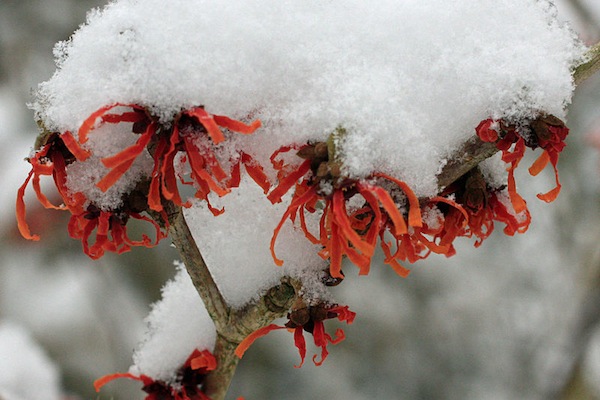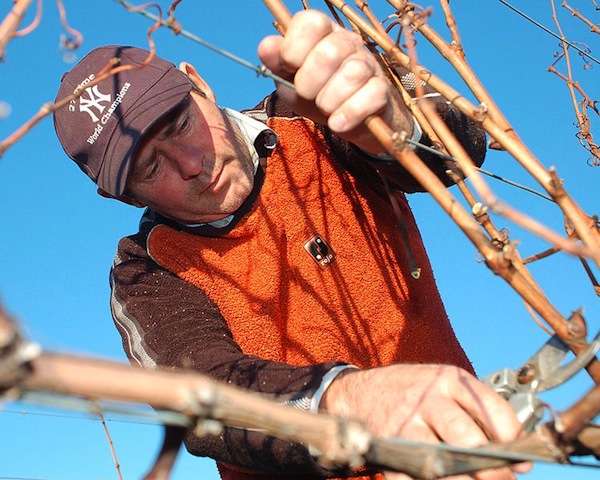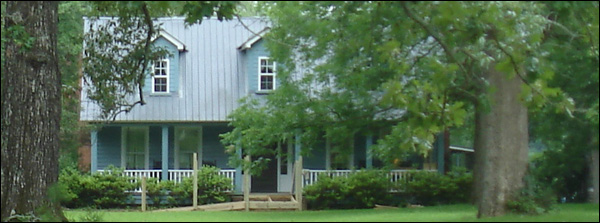The Winter Solstice Confronts the Lazy Gardener
The Winter Solstice Confronts the Lazy Gardener
“The gardener’s role is never completed: there is always something needing attention and, at every turn, there are rewards—joys, gifts—for the gardener that make it easier to get off one’s lazy behind.”—William A. Balk, Jr.
Epicurus’ Porch
By William A. Balk, Jr.

 BEAUFORT South Carolina—(Weekly Hubris)—1/20/2014—Like many another scion of Celtic forebears, I celebrate the arrival of the Winter Solstice. Like many another gardener, I rejoice in the coming of the coldest, darkest days of the year. To be sure, I complain about the cold, lament the lack of sunlight, and crave the warm sunny days of summer still to come. But, midwinter’s chill has brought with it a time of repose and retrenchment in the garden: for many of its plants, and for the gardener, as well.
BEAUFORT South Carolina—(Weekly Hubris)—1/20/2014—Like many another scion of Celtic forebears, I celebrate the arrival of the Winter Solstice. Like many another gardener, I rejoice in the coming of the coldest, darkest days of the year. To be sure, I complain about the cold, lament the lack of sunlight, and crave the warm sunny days of summer still to come. But, midwinter’s chill has brought with it a time of repose and retrenchment in the garden: for many of its plants, and for the gardener, as well.
At least that is how I have always thought of the winter garden. I can take these months off, unconcerned with the daily care and work that it usually needs. However, the more I have come to know about plants, about the effects of temperature and sunlight, of moisture, of cycles of freeze and thaw, the more I have realized what amazing undercurrents of activity are taking place during this period of seeming hibernation. And, perhaps even worse, I have come to see how much effect winter garden work can have on the vigor and health of the plants and the garden during the coming warmer, more obviously productive months. To my horror, I have realized that I don’t, in fact, get time off!
This is heartbreaking news for the lazy gardener.
There are welcome rewards, of course, in doing the real work the garden needs at this time of year. The temperature now is a great deal more conducive to hard physical labor such as digging up plants, dividing them, and digging more holes to receive new plants. The garden grows by such means, and a great many plants benefit significantly from such dig-and-divide work.
Our glorious Hemerocallis (day lilies), beautiful Iris, Coreopsis, Delphinium, Hosta—in fact, most clumping perennials eventually begin to choke themselves when the clump grows too large to support its health. They will revive and grow much better if they are dug up with lots of soil around the roots, and cut apart into several smaller clumps of healthy, well-rooted plants, then planted again in new holes dug to fit the root balls.
The Low Country climate where I garden is wonderfully suited for encouraging the new plants to re-establish themselves with substantial, below ground growth during these winter months, although they do usually appreciate an inch or two of mulch to help with the transition.
Winter can be a perfect time for doing some pruning work on trees and shrubs, many of which have gone dormant in the cold months. Avoid pruning azaleas and camellias until after they flower, but trees which have gone truly dormant and have lost their leafy cover give the gardener a clear view of the branch structure. This makes it much easier to identify damaged or diseased branches for immediate removal close to the trunk or main stem.
Similarly, branches which cross over each other, branches which rub together, and “water sprouts” may all be seen and removed. Some shape-improving pruning may be in order as well. (These Clemson University horticulture pages give excellent information on pruning shrubs and trees: http://www.clemson.edu/extension/hgic/plants/landscape/shrubs/hgic1053.html; http://www.clemson.edu/extension/hgic/plants/landscape/trees/hgic1003.html.)
Additionally, Clemson provides excellent information on pruning specific trees and shrubs, such as roses, crepe myrtles, pear trees, etc.

Inevitably, someone asks with fervent anxiety, “When can I prune my hydrangeas?” The answer involves a bit of inquiry and explanation, however, and the questioner usually wants a one-sentence answer. Hydrangeas comprise several different types—species—of shrubs, and removing old branches at the wrong time can make some of them bloom poorly.
The most popular hydrangeas in our gardens are the big-leaf hydrangeas with the big mop heads of pink, blue, or purple flowers—Hydrangea macrophylla. After winter cold has left bare stems with dried brown remnants of last summer’s flowers, it is tempting to cut those stems back to the ground.
Don’t.
That would certainly encourage new growth from the ground in the spring but, on this species, the flower buds form on old stems, not on new growth. It would be OK to prune to the ground—perhaps one out of every three stems—on my older hydrangeas, I do this every year. That way, the old plant is one-third-new every year, and the bloom isn’t hurt at all.
This method is also the one to use if you should need to prune one of the magnificent American native hydrangeas, Hydrangea quercifolia—the gorgeous oakleaf hydrangea.
If you have an “Annabelle” hydrangea or one of its sisters—Hydrangea arborescens—you will find that the blooms come each year from the stems which grow that season. They bloom on new growth, which means they can indeed be pruned in the winter. In fact, if you cut them back after they start growing, you will be removing the new blooms.
Many people will cut “Annabelle” and other H. arborescens nearly to the ground each winter. This doesn’t interfere with the blooming, but it may keep the stems from becoming strong thick stems, over which the big flower heads flop following the first good rain. Better to leave a foot or two or three of old stem when cutting back.
The handsome white “PeeGee” hydrangea, H. paniculata, is sometimes trained as a single trunked “tree,” although it makes a lovely shrub as well. “PeeGee” blooms on new growth, too, and can therefore be cut back when it is dormant. If, however, you cut back the central trunk, the “tree” will grow back as a shrub.
I should add a couple of additional notes about hydrangea pruning and blooming. Some newer types of mop-head hydrangeas are genetically capable of re-blooming in a season. That is, they are able to bloom on old stems and on new growth, too. These, such as “Endless Summer,” are very forgiving of mistaken pruning.
Hydrangeas rarely actually need any pruning. Removing diseased or dead wood may be done at any time, as may removing the old flowers at the very tips of the stems.
And, if you screw up and prune out blooming stems accidentally, fear not. The plant will probably be just fine; it may even grow back more vigorously. You may miss a season of those enchanting flowers, but they, too, should return the following year.

These winter days—some of which, at least, have been cold—have been perfect for raking up some of the fallen leaves. I try to get them before the winds blow them across the road into the woods, where they do wonders for the forest trees but nothing for my garden. The leaves are such wonderful mulch that I gather bags full from curbside collection to augment those that fall from my own trees.
One other enticement to do winter work in the garden is the opportunity to appreciate the beauty of the camellias, which are in bloom from early fall into the spring. The variety of colors and patterns in the flowers of this ancient garden shrub is enough to make a day of raking beneath them a joyous undertaking . . . even for the lazy gardener.
So, I suppose the celebration of the Solstice each winter and the acknowledgment of substantial tasks to perform even in the dormant garden are a kind of reminder to acknowledge the entire, year-long cycle of the garden. The gardener’s role is never completed: there is always something needing attention and, at every turn, there are rewards—joys, gifts—for the gardener that make it easier to get off one’s lazy behind. Most days, anyway.

Note: The three images used to illustrate this column may be found at http://commons.wikimedia.org/wiki/File%3AWitch_Hazel_Covered_By_Snow_In_The_Garden._Hampshire_UK.jpg; http://commons.wikimedia.org, /wiki/File%3ASteve_Lubiana_pruning_at_Granton_Vineyard_Tasmania_2010.jpg, and http://commons.wikimedia.org/wiki/File%3ARakesOldAndNew.jpg, respectively.

10 Comments
Dana Wildsmith
A typically beautifully written piece by Master Gardener Will: Informative without being daunting, sparse without being sketchy. And the advice he offers is all worthy of following. I would, how ever, add one caveat- I have just cut a swath of my Oak Leaf Hydrangea back to the ground to prevent it from taking over our yard. What’s left is still roughly the height and width and depth of one of our tool sheds! I keep expecting one of Mama’s cats to lie down in the middle of that growth and never be seen again.
Mary Laura Jones
Wonderful as always. You are totally at the top of my list to have a phone hangout with. Can you remind me of your telephone numbers? Thank you, Mary Laura
Anita Sullivan
Thanks for the reminder! One of the things I do in winter is to get a head start on all those tiny plants (otherwise known as weeds) that grow between the paving stones, and along the edges. It’s meditative work, and a good excuse to be outside in the cold doing something useful.
diana
Lovely, Will. Would you consider becoming a member of the Mediterranean Garden Society — http://www.mediterraneangardensociety.org — and perhaps contributing an article to our journal? Have a look at the website and we can be in touch. I can put you in touch with the editor, who’s always looking for contributions and you write so well and go right to the heart of the matter — our love of plants and getting our hands dirty.
Will
It is astonishing, dear Dana, how large those things can grow. I noticed this year that the University of South Carolina, as they have built, remodeled, and expanded, have used large areas of Oakleaf Hydrangeas; they’ve grown to massive proportions – with appropriately massive bloom heads, too – even in the areas that seem far too small to contain them. They get severe pruning each year, yet put on a breathtaking show. Thank you for your very kind words, as always.
Will
Mary Laura, it’s such a pleasure to know you read these pieces occasionally! We’ll make that connection, by phone or otherwise, one of these days…with your schedule and with mine, we’ll both have to work hard at finding a chunk of time when we can catch up on the missing decades. Contact info coming …
Will
Anita Sullivan – whose poetry and essays inspire me to try to become THAT good – you are so right about those tiny plants. However, as I am after all the LAZY gardener, mine are only momentarily tiny. It seems that if I simply glance away for a second, a look again at those invading weeds shows me inches-high plants that threaten to spread seeds any second – in WINTER! You’re correct to brave the brisk weather and do what must be done. Looking out my window right now, I can see today is ideal…before the next arctic vortex swoops down on us.
Will
Ah, Diana. I’ve visited the web site before, and find y’all’s endeavors fascinating. I love the “field trips”! Yes, it would be an honor to join, and I’d be pleased to try to figure out SOMETHING that could possibly be of interest to such a varied and informed group. (Maybe I should take a research expedition with the group before offering a bit of writing? Now, can I find a way for a sugar daddy to pay for it….?) As always, Diana, thank you for your kind words (both to me and to the world with your wonderful essays).
diana
Will, much as I’d love you to visit, you can be a contributor without setting foot here. The fascinating discussion about hydrangeas on FB might easily turn into an article and I’m sure you have lots more material. We have soggy areas in the Med too — Corfu can be alarmingly wet. I’ll give you the editor’s email — don’t feel pressured! And you can get in touch IF you feel like it. Your essays are a gift, so full of love of people and of the earth.
Will
Diana, you are so kind! BTW, I’m a member of the Mediterranean Garden Society – such glorious excursions you all have!